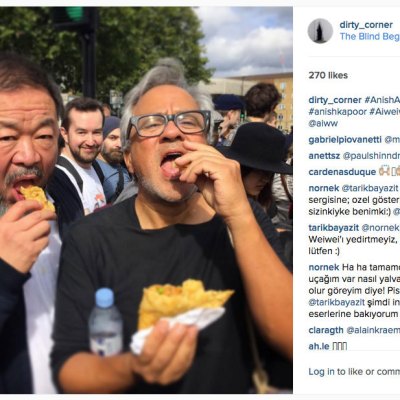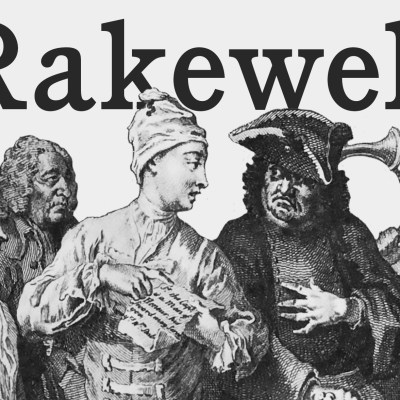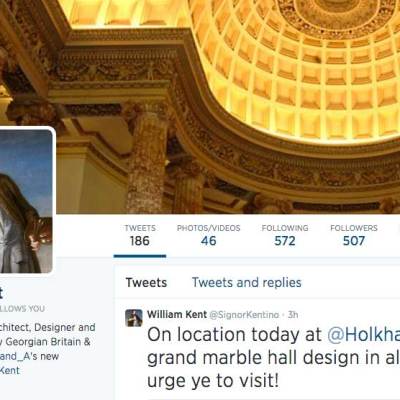From the December issue of Apollo: preview and subscribe here
Can artists and the wider art world use social media for more than marketing or self-promotion? The most exciting practitioners now working across digital platforms certainly think so
The arrival of a new passport is not usually newsworthy. But, in July 2015, when the Chinese artist and activist Ai Weiwei posted a photo of himself with his new passport to image-sharing website Instagram, the world responded with barely contained excitement. The story was covered by the New York Times, CNN, and Time among others.
The photo was newsworthy for a number of reasons: the first was that since his 81-day detention by the Chinese authorities, Ai had had his passport confiscated and was denied foreign travel. The arrival of a new passport therefore seemed to suggest a softening of the government’s stance on Ai’s art and activism. The second is that Ai Weiwei has become something of a cause célèbre in the West. There are cynical reasons for this, for while his activism is widely praised, his art has often been criticised as simplistic or shallow. But by fêting an artist whose work has been banned in his own country, Western art institutions are able subtly to trumpet their own liberal humanist beliefs without offending anyone important closer to home.
Arguably, museums stand to gain more from an exhibition of Ai’s work than Ai does himself. His online reach is huge: he has 297,000 followers on Twitter, 175,000 followers on Instagram, and, as that passport photo showed, his every move is eagerly followed by the world’s media. With this kind of impact, it’s hardly surprising that global art institutions – many of which are struggling to come to terms with wholesale cuts in public funding – should seek a little of Ai’s mass allure. The fact that his only involvement in these exhibitions was from a distance seems not to have been a deterrent. During his confinement within China, exhibitions of his work were held in Washington, New York, Berlin, and San Francisco. Since the return of his passport, Ai has attended openings at Helsinki Art Museum and the Royal Academy of Arts in London, and been appointed professor at the Universität der Künste Berlin.
The excitement around Ai Weiwei’s every move is great news for digitally savvy art institutions. The Royal Academy has held an hour-long question-time with the artist on Twitter, held a successful Kickstarter crowdfunding campaign to bring his tree sculptures to its Burlington House courtyard, and programmed a special late-night opening entitled ‘Digital (Dis)connections’, featuring sensory installations, workshops on artificial intelligence, and classes on how to counter government surveillance. ‘The response has been extraordinary,’ says Nick Sharp, the RA’s head of digital. ‘Our audience changes for each show at the RA, but you can definitely see a different sort of visitor for Ai Weiwei. ‘Digital (Dis)connections’ placed the show at the heart of a lively evening full of innovative programming. Nearly half the visitors to the Late were aged 18–29, which is quite a departure for the RA.’
Such initiatives demonstrate the art world’s growing enthusiasm for all things digital. In recent years, museums and galleries have come to see the internet not simply as a useful marketing tool, whose aim is solely to increase visitor figures or online sales. Rather, the digital realm has become another environment in which institutions can realise their aims. Digitisation has been widely championed as a way of presenting pieces from a collection or archive that are not on public display for reasons of space, fragility or budget. While this often involves launching custom-made websites, social media can make it simple. In October, for example, Tate posted Pitheads (1974) – nine black-and-white photographs by Bernd and Hilla Becher – on various digital platforms. It received over 4,000 ‘likes’ on Instagram alone.
What museums have realised, the market has realised too. There has been much furore of late around Stefan Simchowitz – art collector, Hollywood producer, and co-founder of MediaVast, a photo-licensing website that was sold to Getty Images for $200 million in 2007. Simchowitz uses Facebook and Instagram to promote young artists, discuss their work with other collectors, and boost the value of these works by exposing them to a mass audience (Simchowitz has more than 73,000 Instagram followers). An early champion of art-market star Oscar Murillo, Simchowitz currently favours sparse, abstract paintings, by the likes of Lucien Smith and Jacob Kassay. Art critic Walter Robinson has christened the genre ‘zombie formalism’ for its lack of originality. In a process that has come to be known as ‘flipping’, the works are then sold on for quick and sizeable profits. Lucien Smith’s painting Secret Lives of Men was sold in 2012 for $10,000 and then resold a year later for $319,135. As Katya Kazakina pointed out in Bloomberg Business, that’s an increase of more than 3,000 per cent.
Artists themselves have responded to the rise of social media sites such as Instagram in creative ways. Since closing her East London gallery La Scatola in 2013, curator Valentina Fois has used the gallery’s website as an online platform for a series of digital residencies under the title #Post and #Post2. Some 24 artists, including Sarah Maple, Emilie Gervais, and Lawrence Lek, have now produced works for the site. These have included videos, animations, images, and text – many of which could only ever exist online. ‘Contemporary art derives from conditions and influences particular to our society,’ says Fois, who recently curated a ‘pavilion’ for The Wrong – the world’s largest digital art biennale. ‘In Western societies many of these parameters are formed by digital technology. It is therefore unavoidable that artists are influenced by the internet and digital technology.’
A number of the artists taking advantage of new platforms are unashamed tech-enthusiasts, uncritically championing the latest technology. The more interesting, however, take up a position of ambivalence. Several of this latter group share an interest in exploring the performance of identity, and how this is being shaped by new technologies. Helen Carmel Benigson makes rap videos and appears on Twitter as Princess Belsize Dollar. On Instagram, Amalia Ulman launched Excellences & Perfections – an online performance in which the artist pretended to be an aspiring LA actress undergoing cosmetic surgery. In reality, she was recovering from a serious bus crash. Ulman is one of the ‘post-internet’ artists loudly championed by Simchowitz. Fois cites her work as ‘a great example of how to use social media as a canvas’.
In some ways, Ulman’s work is typical of a new generation of internet-savvy artists, for whom social media is one means of self-expression among others. Characteristic of such works is the blurring of the lines between fact and fiction. Ulman was not the person she pretended to be; nor did she undergo breast augmentation, as her Instagram posts claimed. But she did attend pole-dancing lessons, and, according to a feature by Michael Connor on rhizome.org, she did strictly follow the ‘Zao Dha Diet’. Further investigation, however, suggests that even this diet may be the work of an artist: its website is defiantly old-fashioned (a common characteristic of ‘post-internet’ art) and the only event associated with the diet was programmed as part of ‘Bold Tendencies’ – an annual art exhibition in a multistorey carpark in Peckham, south London.
Such tricksiness may be a recurring attribute of this kind of art, but this is not simply postmodern game-playing for its own sake. Certain common themes have emerged: alienation, community, the constructed nature of identity, our relationship with technology, our always-mediated understanding of truth and reality, and the fetishisation of appearance. Much of this work is highly political – bound up with a feminist, anti-racist critique of neoliberal economics (something entirely missing from, for example, Richard Prince’s appropriation of Instagram images for an exhibition at Gagosian).
In 2015 Benigson had a solo show at Carroll / Fletcher gallery in London entitled ‘Anxious, Stressful, Insomnia Fat’. Across video and installation, the artist repurposed online imagery in order to explore both the way that the internet exerts normative pressures on the individual and the relationship between the virtual and the physical body. The internet is often hailed as a safe space for empowering self-expression. What such work, and comparable projects by the likes of Sarah Maple and Tamsyn Challenger demonstrate is rather how existing structures of power are played out again and again online.
Particularly instructive here is the work of Jesse Darling, whose online output – across Instagram, Twitter, Facebook, and Tumblr – has sometimes overshadowed an artistic practice that includes sculpture and installation as well as a version of Antigone for the Serpentine. Last year, for example, Darling was described by Steph Kretowicz on dazeddigital.com as best known for her ‘unmediated, self-revealing Twitter performance’. The artist quickly rejected that description. ‘I see my “social media activity” as pretty typical for someone roughly of my age and demographic,’ she told me via email.
But Darling’s rejection is more complex than it may first seem. ‘The only way to survive Facebook is to see it as a stage of sorts,’ she said in 2012, ‘and to see yourself as a performer.’ That such activity is a performance is widely acknowledged. But does that make it art? Darling no longer believes this to be true. Instead, she compares the social media use of today’s artists to the diaries of Andy Warhol or the notebooks of David Wojnarowicz: ‘read and distributed among peers, partially immediate and partially archive, and seen – crucially, and with no real ambiguity – as ancillary to the work itself’.
So why is there so much confusion around Darling’s own online activity? Partly perhaps it’s the role-playing of artists such as Ulman. Partly, it’s Darling’s own public output, the register of which varies dramatically, from Twitter idiom to the formality of the lecture theatre. Darling herself has a more interesting explanation: she argues that the ‘persistent reading’ of her social media activity as art is ‘a sexist trope that collapses the “low work” of the social media user into the idea that alterity [women, queers, anything beyond whiteness] can only self-autobiographise, because all it can understand with any authority is itself’. Nobody makes the same assumptions about, say, Gilbert and George.
On the RA’s website is a list of Ai Weiwei’s most memorable aphorisms. At the top is one from a 2011 Der Spiegel interview: ‘Life is art. Art is life. I never separate it.’ What the work of Ulman, Darling, Benigson et al. demonstrates is that Ai is too glib here. Indeed, while his art was travelling the world, Ai’s physical body was placed under house arrest. An artist’s life and their work have never been simply separate or simply the same. Because our lives are now lived through images that, formally at least, are indistinguishable from art, this relationship is now harder to read than ever.


